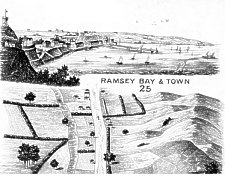
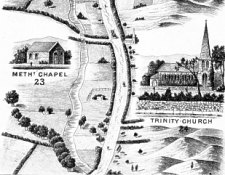
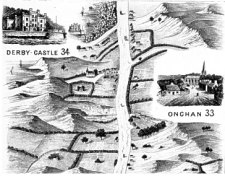
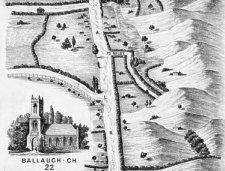
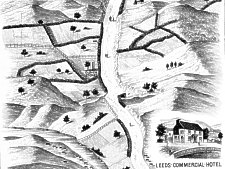
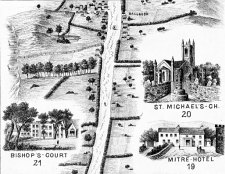
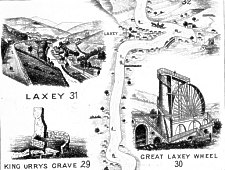
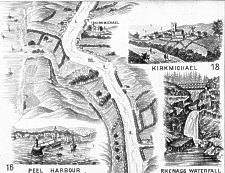
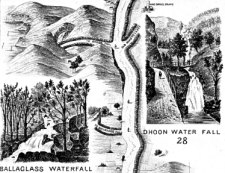
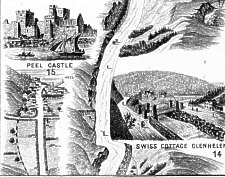
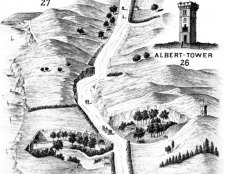
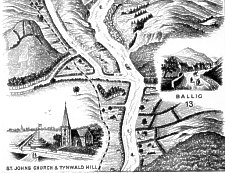
Above
Note these views are looking south towards Douglas
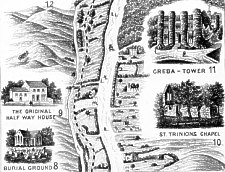
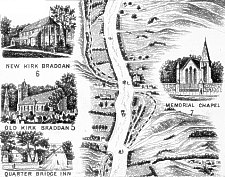
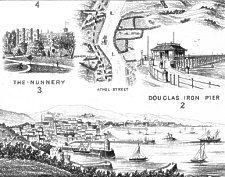
This dates from c.1875 and is a strip map of the route of the "Long route Douglas to Ramsey" which had become a tourist attraction involving a day long circular trip by horse drawn charabanc from Douglas - Ballacraine - Kirk Michael - Ramsey - Laxey - Douglas. It comprises two Leporello strips, a small map and a textual description of the routes and some of the attractions. The main strip map, which would be the main selling point, is printed on good quality glossy china thin card , the other sections on poor quality paper. It is probable that the main strip was printed in Saxony as the paper and images are very similar to those known to be of German origin but the considerably inferior other strip and text were printed locally.
Samuel Webb came to the Island in 1858 and established a shop selling typical souvenirs to a rapidly growing tourist trade, by the time of this panorama he was established in the impressive "Public Lounge" in Strand Street.
— The following sketches of some of the leading features of the scenery in Manxland have been placed before the public through the enterprise of Mr. Webb of Douglas. The sketches are from the pencil of an artist of high standing and acknowledged ability. Mr. Webb has long felt that a work such as the present, published in a neat, handy form would serve to supply a want of long standing. Faithfulness and accuracy he trusts will be found the leading characteristics of the work; this having been the chief task of those to whom its execution has been entrusted. — Mr. WEBB is the proprietor of the PUBLIC LOUNGE, Strand Str. DOUGLAS. It is a fine handsome building, with an imposing front, the large windows being admirably adapted for the display of a portion of the elegant and costly stock. The interior of the building is most commodious, and ample space is afforded for the exhibition of the countless wares in which the proprietor deals; any and every toy from the tiniest plaything to the handsomest and most costly piece of mechanism can be procured at the LOUNGE, or if the purchaser's taste runs upon trinkets and jewelry of costly material and cunning workmanship he can also be accommodated. To possess such a building as the LOUNGE specially designed, built and adapted for the trade and stocked as it is with everything visitors can desire in the shape of articles pleasing, useful, ornamental, amusing, elegant and instructive is the lot of few watering places, whatever their pretensions may be.
We now propose to give a short description of the island itself, its geographical, social and political position. — lt is situated west of England and north east of Ireland and is about 75 miles distant from Liverpool, 40 from Barrow (the two favorite routes to the Island) 194 from Dublin. Its greatest length is 33¼ miles, whilst in breadth it varies from 9 to 12 miles. Generally speaking the journey from Douglas to Peel is the one from which visitors to the Island form their idea of its breadth. The distance is about 11 miles, but the average width much less. The circuit of the Island by the present available highways and bridle paths is about 80 miles, and it is about the same distance by sea. A good idea of the extent of the Island may be gathered from the fact that a pedestrian in a day's walk has touched the doors of every parish church in the Island, — seventeen in number. — There are about 130,000 statute acres in the Isle of Man. Manxmen were intensely superstitious in the olden time and many of the tales which have been preserved are very quaint and odd; they were also devout believers in witchcraft and fairies.
The historical account of the Island shows a chequered career. From the sixth to the tenth century it was ruled by Welsh princes; from that time until the middle of the thirteenth century, Islanders had for their masters the stern and hardy Norsemen, from whom it passed to the monarchs of Scotland. The kings of England then in turn possessed it, but its actual rulers were the great Lords to whom it was granted by successive reigning monarchs. Ultimately the princely house of Stanley became the sovreigns of Man and their rule lasted for some three centuries. The house of Stanley was succeeded by that of Athol or Athole and once more the Islanders owned a Scot for their Lord. From John, Duke of Athol, it passed to the British Crown by purchase in 1765 and from that time forward the successive rulers have been Lieutenant Governors appointed by the Crown. The Island has its own parliament consisting of 24 members, popularly elected, and a council of officials, Eight in number presided over by the Lieut. Governor. The council consists of the Bishop, the judges of the Island and other chief officials; legislation is perfectly free, but the Royal assent is required to every measure passed by the Insular Legislature before becoming law. English acts of parliament do not extend to the Island unless it is specially named, which is very rarely the case.
The bishopric of the Island is one of the most ancient in the kingdom; its occupant has a seat in the house of Lords, but has no right to take any part in the deliberations of that august assembly. The Isle of Man at the last census contained upwards of 53000 souls; it has no staple industry, its people principally supporting themselves by agriculture and fishing. There are few manufactories; the principal is the Sail cloth Works at Tromode, the Cloth Works at the Union Mills and the Net manufactories at Peel.
Douglas is the chief town of the island. It may be said to have been built within the last half century. It is true that the lower portion of the town is very ancient, but it is rapidly getting blocked out to make room for new and imposing buildings, As Douglas has progressed year by year, terrace after terrace. and street after street have been added until it has now become an imposing and fast increasing town, and looking at it from the sea, it cannot fail to elicit feelings of admiration from the beholder. Douglas is a town of about 14000 inhabitants, but it contains accommodation for at least 60,000. The visitor is landed at a magnificent low-water landing pier, a splendid structure stretching far out into the bay. Along the margin of the bay there has been formed a noble promenade, constructed upon sea beach wrested from old Father Neptune; the promenade stretches to the Iron pier, a structure running out about a 1000 feet from the shore, of ornamental design and elegant construction; a little further on to the west of the road, is CASTLE MONA HOTEL, a stately pile built by the last Duke of Athol who was Lord of Man. Its cost was about £40,000. Douglas contains many handsome buildings and is especially well provided in the matter of churches and places of religious worship. The principal churches are St. THOMAS'S close to the shore; St. GEORGE'S near the centre of the town, St. BARNABAS within a few perches of the landing pier. The Independents have a chapel in Bucks road and the Congregationalists one in Circular Rd. St. ANDREWS Presbyterian church is at the corner of Finch Rd. and St. MARY'S Roman Catholic Church is in Bucks Road — The Post and Telegraphic offices are in Athol St. The chief hotels are the IMPERIAL, the ROYAL, FORT ANN, CASTLE MONA, the BRITISH, the VICTORIA, the ADELPHI, the PEVERILL and the VILLIERS. The Banks are the Bank of Mona, Bucks Road; Dumbell's Banking Company, Limited, Prospect Hill; and the Isle of Man Banking Company, Limited, Athol St. The public charitable institutions are the House of Industry, and the Isle of Man Hospital.
 |
||
 |
 |
|
 |
 |
|
 |
 |
|
 |
 |
|
 |
 |
|
 |
Above Note these views are looking south towards Douglas |
|
 |
||
 |
||
 |
We will now accompany the tourist upon one of the most magnificent excursions which a visit to the Isle of Man affords. It is the journey from DOUGLAS to RAMSEY via BALLACRAINE, GLEN HELEN and KIRK MICHAEL, known as the DOUGLAS TO RAMSEY LONG ROUTE. The exigencies of the work compel us to shew the road as if it were a straight one, but in reality it is wellnigh circular, and indeed by some it is called the circular route. The return journey from RAMSEY is made via LAXEY.
Leaving DOUGLAS we soon find ourselves on the high road to PEEL. Stretching towards the South West extends a pleasant Valley, shaded by stately trees, and through this a trout stream pleasantly ripples. Rising above the belt of trees is THE NUNNERY HOUSE, the residence of John S. G. Taubman Esquire, the Speaker of the House of Keys. It is a handsome edifice, modern in appearance and erected close to the ruins of an ancient nunnery, founded it is said by St. Bridget. There is a right of way through the Nunnery grounds from Douglas, the path leading right to the highway on the other side. The stroll will be found very enjoyable on a fine summer's day. Immediately adjoining the pathway a handsome obelisk has been erected to the memory of Brigadier General Goldie who fell at Inkerman.
Having thus briefly digressed for the purpose of glancing at the pleasant glades of the Nunnery, we will now resume our journey on our right. We catch passing glimpses of handsome mansions and well kept grounds and in a few minutes reach THE QUARTER BRIDGE INN, a pleasant halting place for the pedestrian who has made the circle of the Nunnery grounds. Immediately facing us is the Mansion house of Kirby, the seat of Sir William Leece Drinkwater, the chief Judge of the Island; a quarter of a mile further and we reach a junction of roads, the right hand one leading straight up the Hill past the Cemetry for Douglas and Braddan. The Isle of Man race course immediately adjoins and it is elbowed by the General Lunatic Asylum.
Our course takes us to the left, across the bridge spanning the Douglas and Peel Railway and we are at KIRK BRADDAN OLD CHURCH, a spot endeared to thousands of visitors by pleasent remembrances. It is now disused and fears are entertained that unless it is carefully attended to, it will fall rapidly into decay. It is a low antique looking building picturesquely situated and covered with ivy.
A few paces further on is KIRK BRADDAN NEW CHURCH. it has been built by public subscription and contains more sitting room than the old church; it is a cold, unpretentious looking building.
A pretty well sheltered village UNION MILLS is next reached; to the left are the Woollen and Flour Mills, from which the village derives its name, whilst on the right stands a neat-looking chapel. It is a memorial erected to keep green the memory of Mr. Dalrymple, former owner of the Mills. The road from here gradually ascends and some glimpses of magnificent mountain and valley scenery reward the traveller.
The next village on our road is Crosby, the new parish church of Marown being passed on our left and soon we arrive at the ruins of ST. TRINIONS CHURCH. It is situated close to the foot of Greba Mountain, but is now almost in ruinous decay. It is said to have been built as a thank-offering in remembrance of an escape from the dangers of a perilous sea voyage. It is built of the common flagstone of the neighbourhood and is quite roofless. Popular legend asserts that it never possessed a roof inasmuch as an evil spirit — (Buggane in Manx) — amused himself by stripping the roof off, as fast as the industry of the builders put it on. The ruins are about 70 feet long and 25 broad and are well sheltered by trees of which there is an abundance.
Close to and still on the right is GREBA CASTLE or Tower and Stanley mount. The former is now kept as an Hotel, and is charmingley situated amongst the trees, From the tower of the Castle a magnificent, scenic panorama of wood mountain and valley can be obtained. From the pleasure grounds adjoining (but not belonging to the Hotel) an easy ascent is afforded up Greba mountain. Half an hour's drive and we reach Ballacraine. Here the road branches off for Ramsey, but we will before pursuing it further first visit St. John's village and Peel.
The village is distant about half a mile from Ballacraine and the only building it contains worthy of notice is a handsome church built of light colored granite. In a line with the church is TYNWALD HILL OR MOUNT, which is of course the centre of attraction to the visitor. From its summit for almost countless years have the laws of the Island been promulgated. It is composed of soil brought it is said from each of the seventeen parishes of the island, and annually Manxmen come by thousands and from every district, to listen to the laws which have been added to the Statute Book of the realm of Man during the year. The ceremony takes place on each fifth of July. A public fair is held on the Green outside the chapel, whilst inside, the Lieut. Governor, the Council and Members of the House of Keys are attending morning service. A Guard of Soldiers line the pathway from the Church to the Mount, where the Laws are promulgated and along which the procession passes. The ceremony over, the procession reforms and returns to the chapel, where a meeting of the Legislature is held.
Peel is distant about three miles westward of St. John's. The journey between the places has little to attract the traveller. Peel or Peeltown is one of the most ancient in the Island; its streets are narrow and irregular and its houses quaint looking. Peel is the home of the herring fishery, and the amount of money that is invested in the trade is very great. The trade returns immense profits in prosperous years. There is also a considerable trade in Net manufacture and ship building. The population of Peel is about 4000. Its bay is a fine stretch of water.
PEEL CASTLE and CATHEDRAL are situated on a rocky Islet about 7 acres in extent, called St. Patrick's Isle after the Irish Saint. The Cathedral is named after his successor St. Germain. To attempt within the limits of this brief notice to convey an accurate idea of the majesty and grandeur of this ancient pile would be impossible. It is a majestic ruin with the varying fortunes of which as a Princely residence, as a fortress, as a Cathedral, almost the whole history of the Island is inseparably associated. Hight Bishops have found a resting place within the shadow of its Cathedral walls. The burial of the first of these prelates dates back more than seven centuries and it is believed that there was a Cathe- dral prior to the one of which the ruins still remain. Two of the Kings of Man died at the Castle and were buried in one of the Insular Abbeys. The Cathedral was of a mixed style of architecture and from time to time has evidently undergone considerable alterations The length inside is 114 feet 6 inches and its greatest breadth 68 feet 6 inches. Thanks to the energy of Lieut. Governor Loch the restoration works at the Cathedral have been carried out with much vigour and with very gratifying success and a pleasant and profitable day can be spent in exploring the Castle and Cathedral, especially the restored portions.
To the Castle itself we can only devote a few lines. The walls are said to have been built about 1793[sic] by the fourth Earl of Derby and are exceedingly massive. Properly manned and armed the Castle must have been a wellnigh impregnable fortress. In olden times State prisoners of high lineage have languished in its dungeons. Eleanor, Duchess of Gloucester, dragged out a miserable captivity of 14 years in one of the Castle's narrow cells. The "King Maker" the Great Earl of Warwick who was banished to the Island wes imprisoned here in a tower, known as Warwick's Prison. Every reader of Six Walter Scott has been made familiar with Peel Castle in his "Peveril of the Peak" and there are few visitors who do not ask to have "Fenella's Tower" pointed out to them. Peel and its ancient castle will ever hold their place among the Chief of the Insular attractions. We must not omit to mention that there is a direct line of railway between Douglas and Peel and that the scale of charges is very moderate.
Ballig. Resuming our drive to Ramsey at Ballacraine we branch off to the right along a well macadamised road through a pleasant country. In a few minutes the village of Ballig with its Dye works is passed on the left. It nestles in a pleasant valley and there is a nice view of the cheerful Glen, The drive is now through a charming glen shut in on each side by steep hills, clothed with yellow gorse and purple heather, with the honeysuckle and wild rose in luxuriant abundance. A sudden curve in the road and we reach one of the principal halting places on our journey,
GLEN HELEN WITH ITS SWISS COTTAGE. Some year ago this charming and popular place of resort was unknown to fame, but since it passed into the hands of a public Company, nothing has been spared to enhance its already abundant natural advantages. At the entrance there is a good Hotel built in the Swiss Style and the stream is spanned by a tasteful looking suspension bridge. The Glen itself is shut in by towering hills covered with a forest of trees on the east; but the western slope is not so thickly timbered. The undergrowth is dense and in some places difficult of passage, the foliage is luxuriant in the extreme, whilst the sward is velvet in its softness. There are many rare specimens of fern to be procured in the glen, specimens procurable in no other part of the Island.
To view the beauty of the Glen the visitor can easily select a spot upon the hill side after which a visit can be paid to The Falls, which to some are the principal attraction of the place and are very easy of access. A bridle path leading by the banks of the stream brings the tourists to the Falls situated about a mile from the entrance to the Glen. The path is a winding one and suddenly we gain our first view of the Falls. The stream is crossed by a bridge and the principal Fall is spanned by a very substantial bridge also, from which a magnificent view of the cataract is obtained. The lower Fall is 25 feet in height and by following the pathway marked out by the footsteps of former visitors we reach the central and the other falls of which there are several higher up. Upon any part of the high land it is easy to obtain a coign of vantage from which to view the beauties of the Glen. The return journey may be made along a footpath which traverses the forest of firs which belt the east side of the Glen. We must not omit to mention that the stream has the reputation of being an excellent trout one and that a small charge is made for admission to the Glen.
Leaving Glen Helen we ascend a steep hill, known as Craig Willie's, passing over the brow of which the Mull of Galloway is clearly discernible in the diustance and upon the descent on the other side we have a capital view of mountian and valley scenery, whilst the Mourne mountains may be sen far over the expanse of the sea.
A few miles drive and Kirk Michael is seen on the right lying in the valley at our feet. Its "God's acre" has a peculiar attraction: for there lies the body of Good Bishop Wilson and his Episcopal bretheren Hildesley and Cregeen rest near him The village itself is of the ordinary pattern of country villages, but pleasant and clean and there is in summer time a great display of flowers and flowering plants common to so many Insular villages. The church called after St Michael is a modern edifice substantially built. The principal hotel is the Mitre.
A few miles drive and we reach Bishop's Court the residence of the Bishops of this ancient diocese. The palace is not very stricking in its appearance by by reason of its history; it has an interest in the eyes of Manxmen not difficult to understand They are proud of their ancient See and within the walls of the palace the successive occupiers of the Bisopric have for generations dwelt: there was the home of Good Bishop Wilson and that fact alone is sufficient to awaken a responsive echo in Manx hearts. The building is well sheltered with timber and at the east end there is a chapel.
The next village on our route is Ballaugh. It is a pleasant village and possesses a neat church.
The drive from Ballaugh to Sulby is very interesting and, for a portion of the way the road is well wooded. Close to the village of Sulby is a charming Glen known as Sulby Glen. It is a favourite resort of picnic parties and there is ample space for their accomodation. The scenery in neiberhood is very beautiful, the;turf is soft as velvet pile; the Glen is very picturesque and altogether it is a pleasant halting place.
Resuming our road to Ramsey we pass a well built and substantial Methodist Chapel [Kerrowmoar Primitive Methodist] and gain a good view of St. Trinity Church.
Crossing [the] Sulby[note given erronously as Sulley in all places] we catch our first glimpse of Ramsey, one of the most rising and popular watering places in the Island. It is becoming better known, frequented and appreciated year by year. It is a town of about 4000 inhabitants, but buildings are springing up in all directions and it contains accommodation for a very considerable number of visitors. The shore is of course the place of general resort. There is a splendid beach and the bay is simply magnificent, a glorious Stretch of water from headland to headland. Ramsey now possesses a fine promenade and a low water landing pier, and a capital approach has been made from the town to the shore. The walks and drives in the neighbourhood are excellent the scenery diversified and altogether it is a watering place possessing natural attractions in abundance.
Albert Tower. The walks and drives in the neighberhood of Ramsey are very interesting and the return drive to Dougias is a very pleasant one. To the right we have a view of the Albert Tower erected in memory of visit of Her Majesty and Prince Albert to Ramsey Bay.A short distance from Ramsey a road to the left would take the Tourist to Kirk Maughold village and Church, (but time will scarcely permit him (unless he halts Ramsey for the night) to make this visit. There are several crosses of great antiquity in the Churchyard and from the headland an unsurpassed view of mountain and valley scenery is obtainable.
Returning to thé direct road, Ballaglass-Glen is soon reached and a short halt may well be made. The Glen is a very pretty one, well covered with verdure.The stream which runs through theGlen forms a series of small waterfalls and altogether the effect is very pleasing.
The next halting place on our route is Dhoonglen. Its distance from Douglas is about ten miles and from Laxey about two, and every person will be glad to learn that recently great pains have been taken to make this Glen more attractive still to pleasure Seekers. The falls are reputedly the loftiest in the island, the first precipice down which the water dashes is about 80 feet and the subisdiary fall below is nearly as great.
There is an abundance of trees, the foliage luxuriant, the turf pleasant and the Glen altogether is a charming place to visit in the spring and summer time when nature wears her brightest of green A large rustic bridge crosses the upper fall and standing on this bridge we have a spledid view of the Glen , and the Sea. At the shore good safe boats can be procred for a sea excursion. The return walk through the glen is even more enjoyable than the first impression, the beauty of the scene is more apparent and the falls have a more striking effect.
King Orry's Grave. Leaving Dhoon Glen we are again on the high road en route for Laxey and soon there is reached on the right hand side of the road a tall upright stone some ten feet high, which is popularly supposed to mark the last resting place of the great and wise Manx potentate, King Orry. The stone has evidenly at some period been surrounded by a circle of other stones, probably marking the last abode of his "warriors and chiefs" . A few minutes drive and : Laxey Wheel, the great water wheel used for pumping water from the extensive lead and silvermines at Laxey comes to view. The wheel is named " the Lady Isabella" after the wife of a former Lieut. Governor of the Island (Governor Hope). It is supposed to be the second largest wheel in the world and was set up in 1854 by a manxman and the poeple of Laxey take a just pride in what they commonly call " the big wheel" . Its diameter is over 72 feet. Its circumference 217 feet and in breadth it is 6 feet. It raises 250 Gallons of water per minute from a depth of 200 fathoms Laxey is itself a thriving and prosperous village, situate in a charming Glen and possesses a fine bay. The mines give employment to about 300 hands and for many years the yield of lead has been so great that they have eome to be looked upon as the shareholders' El Dorado. There are several good hotels in the village, the chief being the Commercial (of which we give a view) a hostelry of established fame. Recently to the attractions of Laxey a fine pleasure Park has been added. In the Park a splendid refreshment room has been built with a large hall adjoining. The building is in the Swiss style and has a very good effect. A road to the right from the mines leads to. Snaefell, the highest of our Insular mountains. Its altitude is 2024 feet and from its summit on a fine day can be seen portions of the three sister Kingdoms and the principality of Wales. The drive from Laxey is very pleasant, the view of sea and coast scenery excellent. About two miles before reaching Onchan village we pass " the Cloven Stones" a cairn which marks the grave of a Welsh prince who landed at Laxey, bent upon subjugating Monas Isle, but who instead met defeat and death at the hands of the Islanders.
Kirk Onchan. Passing through the thriving village of Onchan about two miles from Douglas, the visitor has choice of two roads, one leading past the official residence of the Lieut. Governor of the Island. This is the upper road. The lower one keeps coast wise and at the foot of the steep hill the road branches to the left, past a series of villa residences to Derby Castle Hotel and plesaure Grounds, a tastefully laid out place of public resort. The newly constructed tramway from the Victoria pier to the foot of the hill brings the resort within easy distance of Douglas.
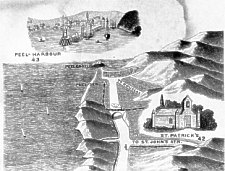 |
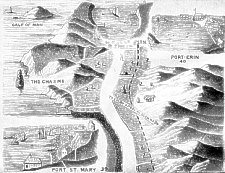 |
|
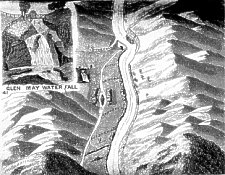 |
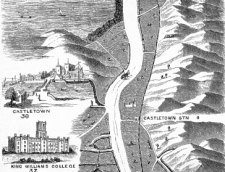 |
|
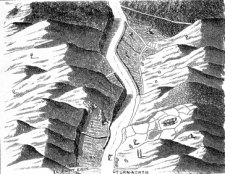 |
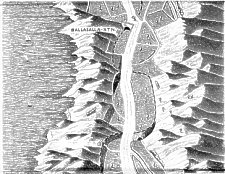 |
|
|
Above Right |
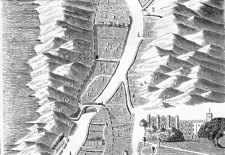 |
[Note the strips are printed on considerably inferior paper which has been waterstained in some places]
The tourist to the South of the Island has a choice of routes, rail and roads. The railway takes him close to the seacoast for nearly the distance, the road is more inland. We select the latter for the purpose of our guide. There are few objects of interest on the journey uniil Castletown is reached. Passing through Ballasalla Village a road to the right leads io the ruins of Rushem Abbey, a spot of especial interest to the antiquarian. Keeping, however, to the road to the left we pass close to King William's College and gain a good view of the village of Derbyhaven and the promontory of Langness. so fatal to many a fine vessel and gallant crew. Hango-hill will also, doubtless, be pointed out to the traveller. Here was executed William Christian, a former receiver General of the Island on a charge of Treason to the English Crown. His fate is now generally regarded as most unjust one. Following the highroad which sweeps the very margin of the bay we reach :
Castletown, a very ancient place and the former metropolis of the Island. lt has a population of about 2560, Until late years it was the seat of the Insular Governement and still the Superior Courts hold many of their sittings there. The chief atiraciion of a visit to Castletown is its ancient eee fortress from which the town takes its name.
Castle Rushen. Few visit Castletown for the first time without making an inspection of this interesting pile, a grim looking edifice, once a bristling fortress which towers over the quaint old town. It is a building of great antiquity erected probably about the beginning of the twelfth Century. As a specimen of massive architecture it is unique and the excellent preservation which it is in, speaks well for the solidity of its construction; here, in ancient times, the Lords of Man kept regal state. The Castle itself is a square keep flanked with a tower on each side, and the whole enclosed by an embattled wall, 25 feet in height and nine in thickness, and protected by seven towers. The moat or ditch which formerly existed has been filled up. The Castle is now used as a prison and in some of the large rooms, serveral Superior Courts of the Island hold their sittings. Inside, the building is worthy of close inspection. The cell in which Bishop Wilson was imprisoned by order of Governor Horn, until released by the King's Mandate, is now used as an office and the visitor will also have pointed out to him the room where the Countess of Derby was imprisoned by the parliamentarians, the ancient chapel and the antique Clock, the latter presented by Queen Elizabeth and which still keeps excellent time. From the Tower of the Castle a grand panoramic view can be had of mountain, valley, sea and coast scenery, of the famous headlands of the South of the Island, and sometimes of the mountains, of the County Down and those of Wales.
Port St. Mary. Half an hour's drive brings the tourist to the prosperous fishing village of Port St. Mary the fishing Station of the South of the Island. There are about 80 fishing smacks belonging to the port and the village is a most thriving one. In any kind of fine weather the Calf Islet is easy of access. From Port St. Mary the visitor can make an easy asccent to inspect the Chasms which are situated on the headland above the village. The inspection of these wonders of nature and the magnificent view from the headland will well repay the time spent in making the visit. Returning to the highroad, a drive of two miles, and we reach
Port Erin, a fishing village which is rapidly developing into a watering place of some note. The bay is a fine stretch of water and a huge breakwater runs out some 900 feet from the quay under the southern headland. The intention of the promoters of the harbour works was to make Port Erin a harbour of refuge for the fishing fleet, but it has been but scantily resorted to. There are two excellent Hotels in the village, and a hotel and pleasure grounds a few hundred yards from the railway Station, and boarding and lodging houses are being built every year as the reputation of Port Erin as a watering place gains yearly. A handsome tower has been erected on Brada-head to perpetuate the remembrance of the long connection which the late Mr. William Milner, the reputed Safe Manufacturer of Liverpool, had with the village, and of his many acts of kindness and generosity shown to its inhabitants.
One of the most glorious drives in the whole Island is from Port Erin to Glenmay and Peel. A five miles drive along the mountain road and the "Round Table" is reached. The bracing air of the mountain side, the magnificent scenery, stretch of sea overhung with precipitous cliffs make the journey a most exhilarating one. The Round Table is the pass between Cronk ny Irey Lhaa and South Barrule, and there are few who, upon reaching this spot for the first time, would not pause to view the grandeur of the highlands of Mona.
Continuing the journey a fine piece of coast scenery is met with at the Niarbyl winding to the right. From here we are on the road to Glenmay, with its picturesque valley and fine waterfall. The drive occupies about half an hour. The village is poor looking and the descent to the Glen is very steep. The principal inn is called the Waterfall-Hotel A few minutes walk from there, across a couple of meadows, brings us to the Glen which is certainly "with verdure clad" . There is a perfect forest of trees through which walks are pierced in various directicns and the whole place is literally embowered withfoliage. The Fall itself is not so lofty as the principal Fall at Glen Helen or Dhoon, but yet, nevertheless,is well worthseeing. The charm of the place is the Glen which stretches right to the sea. There are several interesting caves on the coast, but they are only accessible at low water. The drive from Glenmay to Peel is a pleasant one of about an hour's duration.
|
|
||
|
|
||
|
Any comments, errors or omissions gratefully received
The Editor |
||